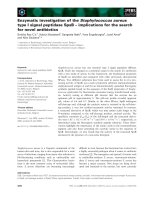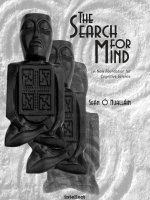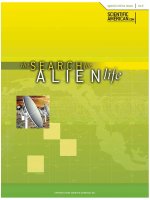carl sagan - the varieties of scientific experience--a personal view of the search for god
Bạn đang xem bản rút gọn của tài liệu. Xem và tải ngay bản đầy đủ của tài liệu tại đây (2.46 MB, 202 trang )
PENGUIN BOOKS
THE VARIETIES OF
SCIENTIFIC EXPERIENCE
Carl Sagan (November 9, 1934–December 20, 1996) was professor of astronomy and space sciences
and director of the Laboratory for Planetary Studies at Cornell University. He played a leading role in
the Mariner, Viking, and Voyager spacecraft expeditions to the planets, for which he twice received
the NASA Medals for Exceptional Scientific Achievement. Dr. Sagan received the Pulitzer Prize and
the highest awards of both the National Academy of Sciences and the National Science Foundation
and many other awards for his contributions to science, literature, education, and the preservation of
the environment. His book Cosmos (accompanying his Emmy and Peabody Award–winning television
series of the same name) was the bestselling science book ever published in the English language, and
his bestselling novel Contact was turned into a major motion picture.
Dr. Sagan was among the first to alert the public to the danger of global warming and the potential
climatic consequences of nuclear war. In the 1980s he initiated the campaign to forge an alliance
between religion and science to protect the environment.
THE VARIETIES of SCIENTIFIC EXPERIENCE
A Personal View of the Search for God
CARL SAGAN
Edited by ANN DRUYAN
Illustrations Editor and Scientific Consultant Steven Soter
PENGUIN BOOKS
Published by the Penguin Group
Penguin Group (USA) Inc., 375 Hudson Street, New York, New York 10014, U.S.A. • Penguin Group (Canada), 90 Eglinton Avenue
East, Suite 700, Toronto, Ontario, Canada M4P 2Y3 (a division of Pearson Penguin Canada Inc.) • Penguin Books Ltd, 80 Strand,
London WC2R 0RL, England • Penguin Ireland, 25 St Stephen’s Green, Dublin 2, Ireland (a division of Penguin Books Ltd) • Penguin
Books Australia Ltd, 250 Camberwell Road, Camberwell, Victoria 3124, Australia (a division of Pearson Australia Group Pty Ltd) •
Penguin Books India Pvt Ltd, 11 Community Centre, Panchsheel Park, New Delhi–110 017, India • Penguin Group (NZ), 67 Apollo
Drive, Rosedale, North Shore 0632, New Zealand (a division of Pearson New Zealand Ltd) • Penguin Books (South Africa) (Pty) Ltd,
24 Sturdee Avenue, Rosebank, Johannesburg 2196, South Africa
Penguin Books Ltd, Registered Offices: 80 Strand, London WC2R 0RL, England
First published in the United States of America by The Penguin Press, a member of Penguin Group (USA) Inc. 2006
Published in Penguin Books 2007
Copyright © Democritus Properties, LLC, 2006
All rights reserved
Frontispiece figure caption by Ann Druyan,
published in What Is Enlightenment? magazine
Illustrations credits appear on Back Matter.
THE LIBRARY OF CONGRESS HAS CATALOGED THE HARDCOVER EDITION AS FOLLOWS:
Sagan, Carl, 1934–1996.
The varieties of scientific experience: a personal view of the search for God / Carl Sagan; edited by Ann Druyan.
p. cm.
The author’s 1985 Gifford lectures.
Includes bibliographical references and index.
Contents: Nature and wonder: a reconnaissance of heaven—The retreat from Copernicus—The organic universe—Extraterrestrial
intelligence—Extraterrestrial folklore: implications for the evolution of religion—The God hypothesis—The religious experience—Crimes
against creation—The search for who we are—Selected Q&A.
ISBN: 1-4295-8382-7
(pbk.)1. Natural theology. 2. Religion and science. 3. Sagan, Carl, 1934–1996—Religion. I. Druyan, Ann, 1949–II. Title.
BL183.S24 2006
215—dc22 2006044827
Except in the United States of America, this book is sold subject to the condition that it shall not, by way of trade or otherwise, be lent,
resold, hired out, or otherwise circulated without the publisher’s prior consent in any form of binding or cover other than that in which it is
published and without a similar condition including this condition being imposed on the subsequent purchaser.
The scanning, uploading and distribution of this book via the Internet or via any other means without the permission of the publisher is
illegal and punishable by law. Please purchase only authorized electronic editions and do not participate in or encourage electronic piracy
of copyrighted materials. Your support of the author’s rights is appreciated.
Editor’s Introduction
Author’s Introduction
1. NATURE AND WONDER: A RECONNAISSANCE OF HEAVEN
2. THE RETREAT FROM COPERNICUS: A MODERN LOSS OF NERVE
3. THE ORGANIC UNIVERSE
4. EXTRATERRESTRIAL INTELLIGENCE
5. EXTRATERRESTRIAL FOLKLORE: IMPLICATIONS FOR THE EVOLUTION OF RELIGION
6. THE GOD HYPOTHESIS
7. THE RELIGIOUS EXPERIENCE
8. CRIMES AGAINST CREATION
9. THE SEARCH
SELECTED Q & A
Acknowledgments
Figure Captions
Index
Editor’s Introduction
Carl Sagan was a scientist, but he had some qualities that I associate with the Old Testament. When
he came up against a wall—the wall of jargon that mystifies science and withholds its treasures from
the rest of us, for example, or the wall around our souls that keeps us from taking the revelations of
science to heart—when he came up against one of those topless old walls, he would, like some latter-
day Joshua, use all of his many strengths to bring it down.
As a child in Brooklyn, he had recited the Hebrew V’Ahavta prayer from Deuteronomy at temple
services: “And you shall love the Lord your God with all your heart, with all your soul, with all your
might.” He knew it by heart, and it may have been the inspiration for him to first ask, What is love
without understanding? And what greater might do we possess as human beings than our capacity to
question and to learn?
The more Carl learned about nature, about the vastness of the universe and the awesome timescales
of cosmic evolution, the more he was uplifted.
Another way in which he was Old Testament: He couldn’t live a compartmentalized life, operating
on one set of assumptions in the laboratory and keeping another, conflicting set for the Sabbath. He
took the idea of God so seriously that it had to pass the most rigorous standards of scrutiny.
How was it, he wondered, that the eternal and omniscient Creator described in the Bible could
confidently assert so many fundamental misconceptions about Creation? Why would the God of the
Scriptures be far less knowledgeable about nature than are we, newcomers, who have only just begun
to study the universe? He could not bring himself to overlook the Bible’s formulation of a flat, six-
thousand-year-old earth, and he found especially tragic the notion that we had been created separately
from all other living things. The discovery of our relatedness to all life was borne out by countless
distinct and compelling lines of evidence. For Carl, Darwin’s insight that life evolved over the eons
through natural selection was not just better science than Genesis, it also afforded a deeper, more
satisfying spiritual experience.
He believed that the little we do know about nature suggests that we know even less about God.
We had only just managed to get an inkling of the grandeur of the cosmos and its exquisite laws that
guide the evolution of trillions if not infinite numbers of worlds. This newly acquired vision made the
God who created the World seem hopelessly local and dated, bound to transparently human
misperceptions and conceits of the past.
This was no glib assertion on his part. He avidly studied the world’s religions, both living and
defunct, with the same hunger for learning that he brought to scientific subjects. He was enchanted by
their poetry and history. When he debated religious leaders, he frequently surprised them with his
ability to out-quote the sacred texts. Some of these debates led to longstanding friendships and
alliances for the protection of life. However, he never understood why anyone would want to
separate science, which is just a way of searching for what is true, from what we hold sacred, which
are those truths that inspire love and awe.
His argument was not with God but with those who believed that our understanding of the sacred
had been completed. Science’s permanently revolutionary conviction that the search for truth never
ends seemed to him the only approach with sufficient humility to be worthy of the universe that it
revealed. The methodology of science, with its error-correcting mechanism for keeping us honest in
spite of our chronic tendencies to project, to misunderstand, to deceive ourselves and others, seemed
to him the height of spiritual discipline. If you are searching for sacred knowledge and not just a
palliative for your fears, then you will train yourself to be a good skeptic.
The idea that the scientific method should be applied to the deepest of questions is frequently
decried as “scientism.” This charge is made by those who hold that religious beliefs should be off-
limits to scientific scrutiny—that beliefs (convictions without evidence that can be tested) are a
sufficient way of knowing. Carl understood this feeling, but he insisted with Bertrand Russell that
“what is wanted is not the will to believe, but the desire to find out, which is the exact opposite.” And
in all things, even when it came to facing his own cruel fate—he succumbed to pneumonia on
December 20, 1996, after enduring three bone-marrow transplants—Carl didn’t want just to believe:
He wanted to know.
Until about five hundred years ago, there had been no such wall separating science and religion.
Back then they were one and the same. It was only when a group of religious men who wished “to
read God’s mind” realized that science would be the most powerful means to do so that a wall was
needed. These men—among them Galileo, Kepler, Newton, and, much later, Darwin—began to
articulate and internalize the scientific method. Science took off for the stars, and institutional
religion, choosing to deny the new revelations, could do little more than build a protective wall
around itself.
Science has carried us to the gateway to the universe. And yet our conception of our surroundings
remains the disproportionate view of the still-small child. We are spiritually and culturally
paralyzed, unable to face the vastness, to embrace our lack of centrality and find our actual place in
the fabric of nature. We batter this planet as if we had someplace else to go. That we even do science
is a hopeful glimmer of mental health. However, it’s not enough merely to accept these insights
intellectually while we cling to a spiritual ideology that is not only rootless in nature but also, in
many ways, contemptuous of what is natural. Carl believed that our best hope of preserving the
exquisite fabric of life on our world would be to take the revelations of science to heart.
And that he did. “Every one of us is, in the cosmic perspective, precious,” he wrote in his book
Cosmos. “If a human disagrees with you, let him live. In a hundred billion galaxies you will not find
another.” He lobbied NASA for years to instruct Voyager 2 to look back to Earth and take a picture
of it from out by Neptune. Then he asked us to meditate on that image and see our home for what it is
—just a tiny “pale blue dot” afloat in the immensity of the universe. He dreamed that we might attain
a spiritual understanding of our true circumstances. Like a prophet of old, he wanted to arouse us
from our stupor so that we would take action to protect our home.
Carl wanted us to see ourselves not as the failed clay of a disappointed Creator but as starstuff,
made of atoms forged in the fiery hearts of distant stars. To him we were “starstuff pondering the
stars; organized assemblages of 10 billion billion billion atoms considering the evolution of atoms;
tracing the long journey by which, here at least, consciousness arose.” For him science was, in part, a
kind of “informed worship.” No single step in the pursuit of enlightenment should ever be considered
sacred; only the search was.
This imperative was one of the reasons he was willing to get into so much trouble with his
colleagues for tearing down the walls that have excluded most of us from the insights and values of
science. Another was his fear that we would be unable to keep even the limited degree of democracy
we have achieved. Our society is based on science and high technology, but only a small minority
among us has even a superficial understanding of how they work. How can we hope to be responsible
citizens of a democratic society, informed decision makers regarding the inevitable challenges posed
by these newly acquired powers?
This vision of a critically thoughtful public, awakened to science as a way of thinking, impelled
him to speak at many places where scientists were not usually found: kindergartens, naturalization
ceremonies, an all-black college in the segregated South of 1962, at demonstrations of nonviolent
civil disobedience, on the Tonight show. And he did this while maintaining a pioneering,
astonishingly productive, fearlessly interdisciplinary scientific career.
He was especially thrilled to be invited to give the Gifford Lectures on Natural Theology of 1985
at the University of Glasgow. He would be following in the footsteps of some of the greatest
scientists and philosophers of the last hundred years—including James Frazer, Arthur Eddington,
Werner Heisenberg, Niels Bohr, Alfred North Whitehead, Albert Schweitzer, and Hannah Arendt.
Carl saw these lectures as a chance to set down in detail his understanding of the relationship
between religion and science and something of his own search to understand the nature of the sacred.
In the course of them, he touches on several themes that he had written about elsewhere; however,
what follows is the definitive statement of what he took pains to stress were only his personal views
on this endlessly fascinating subject.
At the beginning of each Gifford Lecture, a distinguished member of the university community
would introduce Carl and marvel at the need for still more additional halls to accommodate the
overflow audience. I have been careful not to change the meaning of anything Carl said, but I have
taken the liberty of editing out those gracious introductory remarks as well as the hundred or more
notations on the audio transcripts that merely say “[Laughter].”
I ask the reader to keep in mind at all times that any deficiencies of this book are my responsibility
and not Carl’s. Despite the fact that the unedited transcripts reveal a man who spoke
extemporaneously in nearly perfect paragraphs, a collection of lectures is not exactly the same thing
as a book. This is especially true when the Pulitzer Prize–winning author in question never published
anything without combing at least twenty or twenty-five iterations of every manuscript for error or
stylistic infelicity.
There was plenty of laughter during these lectures, but also the kind of pin-drop silence that comes
when the audience and the speaker are united in the thrall of an idea. The extended dialogues in some
of the question-and-answer periods capture a sense of what it was like to explore a question with
Carl. I attended every lecture, and more than twenty years later what remains with me was his
extraordinary combination of principled, crystal-clear advocacy coupled with respect and tenderness
toward those who did not share his views.
The American psychologist and philosopher William James gave the Gifford Lectures in the first
years of the twentieth century. He later turned them into an extraordinarily influential book entitled
The Varieties of Religious Experience, which remains in print till this day. Carl admired James’s
definition of religion as a “feeling of being at home in the Universe,” quoting it at the conclusion of
Pale Blue Dot, his vision of the human future in space. The title of the book you hold in your hands is
a tip of the hat to the illustrious tradition of the Gifford Lectures. My variation on James’s title is
intended to convey that science opens the way to levels of consciousness that are otherwise
inaccessible to us; that, contrary to our cultural bias, the only gratification that science denies to us is
deception. I hope it also honors the breadth of searching and the richness of insight that distinguished
Carl Sagan’s indivisible life and work. The varieties of his scientific experience were exemplified
by oneness, humility, community, wonder, love, courage, remembrance, openness, and compassion.
In that same drawer where the transcript of these lectures was rediscovered, there was a sheaf of
notes intended for a book we never had the chance to write. Its working title was Ethos, and it would
have been our attempt to synthesize the spiritual perspectives we derived from the revelations of
science. We collected filing cabinets’ worth of notes and references on the subject. Among them was
a quotation Carl had excerpted from Gottfried Wilhelm Leibniz (1646–1716), the mathematical and
philosophical genius, who had invented differential and integral calculus independently of Isaac
Newton. Leibniz argued that God should be the wall that stopped all further questioning, as he
famously wrote in this passage from Principles of Nature and Grace:
“Why does something exist rather than nothing? For ‘nothing’ is simpler than ‘something.’ Now this
sufficient reason for the existence of the universe…which has no need of any other reason…must be a
necessary being, else we should not have a sufficient reason with which we could stop.”
And just beneath the typed quote, three small handwritten words in red pen, a message from Carl to
Leibniz and to us: “So don’t stop.”
• ANN DRUYAN
Ithaca, New York
March 21, 2006
Author’s Introduction
In these lectures I would like, following the wording of the Gifford Trust, to tell you something of my
views on what at least used to be called natural theology, which, as I understand it, is everything
about the world not supplied by revelation. This is a very large subject, and I will necessarily have to
pick and choose topics. I want to stress that what I will be saying are my own personal views on this
boundary area between science and religion. The amount that has been written on the subject is
enormous, certainly more than 10 million pages, or roughly 10
11
bits of information. That’s a very
low lower limit. And nevertheless no one can claim to have read even a tiny fraction of that body of
literature or even a representative fraction. So it is only in the hope that much that has been written is
unnecessary to be read that one can approach the subject at all. I’m aware of many limitations in the
depth and breadth of my own understanding of both subjects, and so ask your indulgence. Fortunately,
there was a question period after each of the Gifford Lectures, in which the more egregious of my
errors could be pointed out, and I was genuinely delighted by the vigorous give-and-take in those
sessions.
Even if definitive statements on these subjects were possible, what follows is not such. My
objective is much more modest. I hope only to trace my own thinking and understanding of the subject
in the hopes that it will stimulate others to go further, and perhaps through my errors—I hope not to
have made many, but it was inevitable that I would—new insights will emerge.
• CARL SAGAN
Glasgow, Scotland
October 14, 1985
THE VARIETIES
of
SCIENTIFIC EXPERIENCE
NATURE AND WONDER: A RECONNAISSANCE OF HEAVEN
The truly pious must negotiate a difficult course between the precipice of godlessness and the
marsh of superstition.
• Plutarch •
Certainly both extremes are to be avoided, except what are they? What is godlessness? Does not the
concern to avoid the “precipice of godlessness” presuppose the very issue that we are to discuss?
And what exactly is superstition? Is it just, as some have said, other people’s religion? Or is there
some standard by which we can detect what constitutes superstition?
For me, I would say that superstition is marked not by its pretension to a body of knowledge but by
its method of seeking truth. And I would like to suggest that superstition is very simple: It is merely
belief without evidence. The question of what constitutes evidence in this interesting subject, I will
try to address. And I will return to this question of the nature of evidence and the need for skeptical
thinking in theological inquiry.
The word “religion” comes from the Latin for “binding together,” to connect that which has been
sundered apart. It’s a very interesting concept. And in this sense of seeking the deepest interrelations
among things that superficially appear to be sundered, the objectives of religion and science, I
believe, are identical or very nearly so. But the question has to do with the reliability of the truths
claimed by the two fields and the methods of approach.
By far the best way I know to engage the religious sensibility, the sense of awe, is to look up on a
clear night. I believe that it is very difficult to know who we are until we understand where and when
we are. I think everyone in every culture has felt a sense of awe and wonder looking at the sky. This
is reflected throughout the world in both science and religion. Thomas Carlyle said that wonder is the
basis of worship. And Albert Einstein said, “I maintain that the cosmic religious feeling is the
strongest and noblest motive for scientific research.” So if both Carlyle and Einstein could agree on
something, it has a modest possibility of even being right.
Here are two images of the universe. For obvious reasons they concentrate not on the spaces in
which there is nothing but on the locales in which there is something. It would be very dull if I simply
showed you image after image of darkness. But I stress that the universe is mainly made of nothing,
that something is the exception. Nothing is the rule. That darkness is a commonplace; it is light that is
the rarity. As between darkness and light, I am unhesitatingly on the side of light (especially in an
illustrated book). But we must remember that the universe is an almost complete and impenetrable
darkness and the sparse sources of light, the stars, are far beyond our present ability to create or
control. This prevalence of darkness, both factually and metaphorically, is worth contemplating
before setting out on such an exploration.
fig. 1
fig. 2
This image is intended for orientation. It is an artist’s impression of the solar system, in which the
sizes of the objects but not their relative distances are to scale. And you can see that there are four
large bodies other than the Sun, and the rest is debris. We live on the third piece of debris from the
Sun; a tiny world of rock and metal with a thin patina—a veneer—of organic matter on the surface, a
tiny fraction of which we happen to constitute.
This picture was made by Thomas Wright of Durham, who published an extraordinary book in
1750, which he quite properly called An Original Theory or New Hypothesis of the Universe.
Wright was, among other things, an architect and a draftsman. This picture conveys a remarkable
sense, for the first time, of looking at the solar system and beyond, to scale. What you can see here is
the Sun, and to scale to the size of the Sun is the distance to the orbit of Mercury. Then the planets
Venus, Earth, Mars, Jupiter, and Saturn—the other planets were not known in his time—and then, in a
wonderful attempt, here is the solar system, the planets we talked about, all in that central dot and a
rosette to represent the cometary orbits known in his time. He did not go very far beyond the present
orbit of Pluto. And then he imagined, a large distance away, the nearest star then known, Sirius,
around which he did not quite have the courage to put another rosette of cometary orbits. But there
was the clear sense that our system and the systems of other stars were similar.
Here at upper left is the first of four modern illustrations attempting to show just the same thing, in
which we see the Earth on its orbit and the other inner planets. Each little dot is intended to represent
a fraction of the plethora of small worlds called asteroids. Beyond them is the orbit of Jupiter. And
the distance from the Earth to the Sun represented by the scale bar up at the top is called an
astronomical unit. This is the first introduction—there will be many of them that I will talk about—of
a kind of geocentric or anthropocentric arrogance with which all of the human attempts to look at the
cosmos seem to be infected. The idea that an astronomical unit by which we measure the universe has
to do with the Earth’s distance from the Sun is clearly a human pretension. But since it is deeply
embedded in astronomy, I will continue to use the word.
At upper right we see that the previous picture is wrapped in a small square in the middle. Here
we have a scale of ten astronomical units. We cannot make out the orbits of the inner planets,
including the Earth, on this scale. But we can see the orbits of the giant planets Jupiter, Saturn,
Uranus, Neptune, as well as Pluto.
At lower right the previous picture is in a small square, and we now have a scale of a hundred
astronomical units. Here’s a comet—there are many—with a highly eccentric orbit.
Another increase in scale by a factor of ten and we have the picture at lower left. And here the gray
shading is intended to represent the inner boundaries of the Oort Cloud of roughly a trillion comets—
cometary nuclei—that surround the Sun and extend to the boundaries of interstellar space.
This is an artist’s representation of the entire Oort Cloud. Now the dimension is a hundred
thousand astronomical units, and there is an external boundary to the Oort Cloud. All of the planets,
and the comets that we know, are lost in the glare of light from the Sun. And here, for the first time,
we have a scale sufficient to see some of the neighboring stars. So the world that we live on is a tiny
and insignificant part of a vast collection of worlds, many of which are much smaller, a few of which
are much larger. The total number of such worlds are, as I said, something of the order of a trillion, or
10
12
, a one followed by twelve zeros, of which Earth represents just one, all in the family of the Sun.
And our star, of course, is one of a vast multitude.
Here Thomas Wright has made a leap or two, and now we see more than one system with a
cometary rosette. He clearly had the sense of the sky being full of systems more or less like our own
and was as explicit in words as he is here in a picture in his 1750 book, which, by the way, is also
the first explicit statement anywhere that the stars we see in the night sky are part of a concentration of
stars that we now call the Milky Way Galaxy, one with a specific shape and a specific center.
There are a vast number of stars within our galaxy. The number is not so large as the number of
cometary nuclei around the Sun but is nevertheless hardly modest. It’s about 400 billion stars, of
which the Sun is one.









